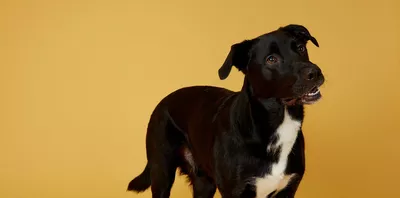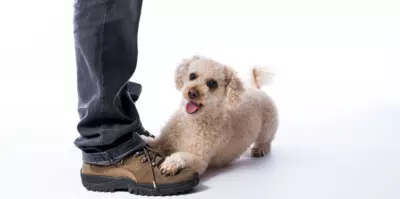Why Do Dogs Wag Their Tails?
- 10 May 2023
- 4m read

For the longest time, we have associated tail wagging with meaning that a dog is happy and overjoyed. Whilst this can be true some of the time, there are lots of other rather interesting reasons behind why your dog’s tail is generating enough power to light a small village.
What is Tail Wagging?
Tail wagging is the side-to-side movement of the tail, at differing speeds. It is a behaviour most often associated with dogs, but that doesn’t mean other animals such as cats, foxes, and wolves don’t like to get involved too.
Can Dogs Control Their Tails?
Yes, dogs can control their tails.
Dogs have a significant degree of control over their tail movement, with the ability to dictate its direction and placement. Pay close attention paw-rents. As dogs often use their tails to communicate, it can be an effective way to understand how your dog might be feeling. However, it’s important to take note of what the rest of your dog’s body is doing too. Their eyes and ears, for example, can be indicative of their level of comfort.
Dogs have a complex set of muscles in their tails that allow them to move them in different ways, including wagging, tucking and holding them high or low.
However, not all tail movements are intentional or within a dog's control. The shape, size and degree of movement of a dog’s tail can vary between different breeds and individual dogs. Certain dog breeds may have naturally short or curly tails that limit their range of motion.
What Does it Mean When a Dog Wags Their Tail?
Tail wagging has different meanings depending on the situation and the way in which the tail is wagging, in addition to how the rest of a dog’s body is behaving. Fun fact, research indicates that dogs tend to wag their tails to the right when they are feeling happy or confident, meanwhile wagging their tails to the left can indicate that they are frightened.
For example, a fluid and loose tail wag might suggest that a dog is comfortable and happy, while a stiff tail wag can often indicate tension. The speed and direction of the wag can also convey different emotions or intentions.
Some of the most common reasons behind why your dog may we wagging their tail include:
Happiness or excitement
The tail will typically be held high and wag quickly from side to side. They might even look like they could take flight at any moment.
Friendliness
This might look like a fluid, loose tail motion to indicate that they are approachable and welcome attention. Bonus wags if you give them a chin scratch, or offer them a treat.
Alertness
A tail that’s held high and stiff with a slow wag suggests a dog is on look out for any potential dangers. Think MI5 agent. The names Bone, James Bone.
Anxiety or nerves
The tail will likely be held low and tucked between their legs or wag with a stiff but rapid motion. A timid little soul needs time and patience, so ensure that you are calm as a cucumber around a dog like this.
Threatened
If the tail looks high with short but rapid wags, a dog may sense danger and be preparing to defend themselves. This could be followed by defensive behaviours, such as barking, as a way to keep potential threats at a distance. Avoid approaching a dog that is displaying this kind of behaviour.
Feed Butternut Box to Get Your Dog’s Tail Wagging
A sure way to set your dog’s tail to hyperdrive mode is to feed them a delicious, nutritionally complete meal that will leave them feeling satisfied.
At Butternut Box, when you sign up we will ask a few details about your dog, such as their breed, age, weight and activity level. This helps us to work out exactly what meals your dog will love, in perfectly-portioned pouches.
Are they a golden oldie? Our Wham Bam Lamb with a dash of turmeric is perfect for supporting their ageing joints. Or maybe they’re a playful pup with an unknown source of never ending energy. In which case, we would suggest Tuck In Chicken with protein-packed quinoa, it’s also nice and easy to digest so it won’t upset their sensitive tums.
Frozen to lock in the goodness, with no added preservatives or fillers. We provide only the best for your precious pooch.




.png)